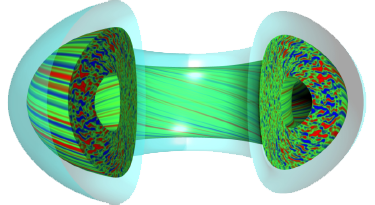Speaker
Description
High bandwidth fluctuation diagnostics capture the fast plasma dynamics of drift wave turbulence and Alfven/MHD instabilities on µs timescales. Fluctuation diagnostics coupled with high throughput compute accelerators, such as field programmable gate arrays (FPGAs), introduce new capabilities for real-time characterization, prediction, and control of fast plasma dynamics. Real-time applications of interest include the onset of edge-localized modes (ELMs), turbulence characterization, pedestal characterization, confinement mode transitions and sustainment, and Alfven/MHD mode activity. Following an “edge ML” strategy, machine learning (ML) inference models are deployed on compute accelerators at the diagnostic sensor to ingest the real-time data stream. The models generate reduced signals that target specific physics applications, and the reduced signals are available for real-time plasma control.
The paper reports on a new initiative to implement edge ML capabilities for real-time ELM onset prediction, turbulence characterization, and confinement mode control using the 2D beam emission spectroscopy (BES) diagnostic system at DIII-D. The 64-channel, 1 MHz 2D BES system at DIII-D captures plasma density perturbations from turbulence and instabilities. Edge ML models transform 10-100 µs data histories from the real-time data stream to a low dimension feature space that services multiple prediction and classification tasks. The feature space is derived from 3D convolution kernels (2D in space, 1D in time) and “colour” channels that correspond to spatial and time derivatives in the input data block. The autoencoder will additionally facilitate the real-time assessment of unseen data to be in or out of the training data distribution. The models will be implemented on FPGAs that buffer the real-time data stream and execute model evaluations with latencies on the order of 10 µs. In practice, achieving low latency, high throughput evaluation on an FPGA imposes constraints on the model architecture. The feature space for present models can predict the explosive onset of ELM events (Figure 1a) with reliable forecasts up to 100 µs, and the predictive capability indicates that precursors for the onset of ELM events are present in the data. Strategies to increase the forecast horizon include bootstrapping the ELM onset prediction model from short prediction horizon with high accuracy to longer prediction. Current work is focused on developing a feature space that jointly captures the explosive growth of ELM events and the spatial-temporal patterns of small-amplitude turbulence (Figure 1b). A real-time turbulence classifier will identify the confinement regime including L-mode, H-mode, and enhanced confinement regimes like the wide-pedestal quiescent H-mode at DIII-D. Real-time signals for turbulence activity can facilitate the plasma control system learning to achieve and sustain enhanced confinement regimes. Closely related to the spatial-temporal patterns of turbulence are flow shear patterns (Figure 1c) and the radial electric field (Er) profile. The Er profile is a critical factor for turbulence dynamics and the edge transport barrier, so an additional classification task can be the real-time characterization of Er profile dynamics on 10-100 µs timescales.
Supported by US DOE Grant No. DE-SC0021157, DE-FG02-08ER54999, and DE-FC02-04ER54698.
| Country or International Organisation | United States of America |
|---|---|
| Affiliation | University of Wisconsin-Madison |

